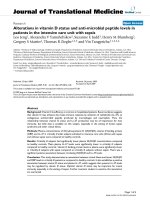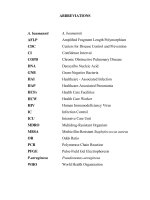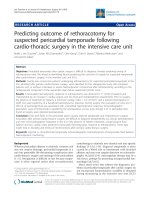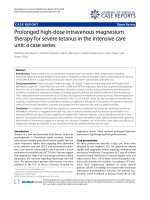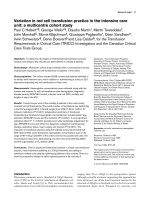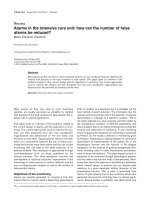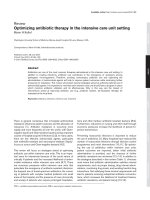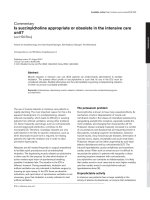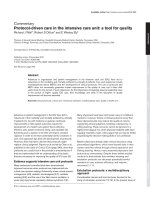Ebook Infection control in the intensive care unit: Part 1
Bạn đang xem bản rút gọn của tài liệu. Xem và tải ngay bản đầy đủ của tài liệu tại đây (1.16 MB, 221 trang )
Infection Control in the Intensive
Care Unit
H. K. F. van Saene L. Silvestri
M. A. de la Cal A. Gullo
•
•
Editors
Infection Control
in the Intensive
Care Unit
Third Edition
Foreword by Julian Bion
123
H. K. F. van Saene
Institute of Aging and Chronic Diseases
University of Liverpool
Liverpool
UK
M. A. de la Cal
Department of Intensive Care Medicine
Hospital Universitario de Getafe
Getafe, Madrid
Spain
L. Silvestri
Department of Emergency and Unit of
Anesthesia and Intensive Care
Presidio Ospedaliero di Gorizia
Gorizia
Italy
A. Gullo
Department of Anesthesia
and Intensive Care
School of Medicine
University Hospital Catania
Catania
Italy
ISBN 978-88-470-1600-2
DOI 10.1007/978-88-470-1601-9
e-ISBN 978-88-470-1601-9
Springer Milan Heidelberg Dordrecht London New York
Library of Congress Control Number: 2011929635
Ó Springer-Verlag Italia 1998, 2005, 2012
This work is subject to copyright. All rights are reserved, whether the whole or part of the material is
concerned, specifically the rights of translation, reprinting, reuse of illustrations, recitation, broadcasting, reproduction on microfilm or in any other way, and storage in data banks. Duplication of this
publication or parts thereof is permitted only under the provisions of the Italian Copyright Law in its
current version, and permission for use must always be obtained from Springer. Violations are liable to
prosecution under the Italian Copyright Law.
The use of general descriptive names, registered names, trademarks, etc. in this publication does not
imply, even in the absence of a specific statement, that such names are exempt from the relevant
protective laws and regulations and therefore free for general use.
Product liability: The publishers cannot guarantee the accuracy of any information about dosage and
application contained in this book. In every individual case the user must check such information by
consulting the relevant literature.
Printed on acid-free paper
Springer is part of Springer Science+Business Media (www.springer.com)
The essential of intensive care is the
prevention of complications
C. P. Stoutenbeek 1947–1998
Foreword
In 1847, Ignatius Semmelweis’s friend and colleague Jakob Kolletschka died of
sepsis after his finger had been cut during a post-mortem examination at the
Allgemeine Krankenhaus in Vienna. Semmelweis made the connection between
the process which caused the death of his friend, and that which caused the postpartum deaths of so many of the mothers in his obstetric clinic at the hospital. His
study of the prevention of puerperal sepsis through effective hand hygiene, and his
subsequent career, are classical examples of how inspired insight may fail to be
translated into effective action because of defective communication, professional
resistance to change, cultural incomprehension that beneficent individuals could
also be agents of harm, and lack of an underpinning scientific mechanism.
No such criticisms can be made of the editors and contributors for this valuable
and successful book, now in its third edition, which brings together international
experts in infection and infection control to review the most recent scientific
evidence in preventing critically ill patients from suffering additional harm through
the acquisition of autogenous and exogenous infections during their hospital stay.
Wider attitudes to one of the components discussed, selective digestive decontamination, do bear some comparison with the Semmelweis story in terms of the
gap between the scientific evidence and implementation in practice. Future editions of this book will no doubt contain additional reflections from the behavioural
sciences. In the meantime, intensive care and infection control practitioners will
find both fact and wisdom in this compendium to guide their practice and improve
patient care.
November 2011
Julian Bion
Professor of Intensive Care Medicine
University Department of Anaesthesia and ICM
Queen Elizabeth Hospital
Edgbaston, Birmingham, UK
vii
Preface
A week-long postgraduate course was organised in Trieste, Italy, in 1994. This
course was extremely popular Europe wide. Participants were so impressed that
they asked for copies of the lectures, and as a result of the many requests, lecturers
were asked to provide a manuscript of their lecture(s). These manuscripts resulted
in the first edition of this book, published in 1998.
This first edition contained five sections, each based on a day of the course,
which comprised six lectures. The five sections Essentials in Clinical Microbiology,
Antimicrobials, Infection Control, Infections on ICU, and Special Topics. The
format remains the same today.
There are two previous editions to this 2011 edition: 1998 and 2005. The
differences between the first edition and this latest one are in the first and last
sections. Two chapters from the first edition are merged in the first section:
Carriage, and Colonisation and Infection. This occurred because 85% of all
infections are endogenous and characterised by these three stages. The other
difference is a chapter on microcirculation and infection in Section 5. Perhaps
the most important difference between the previous editions and this most recent
edition is pictured on the front cover: 15% of all infections are exogenous, and
research over the 6 years since the last edition has shown that topically applied
antimicrobials are able to control exogenous infections. However, topically
applied antimicrobials should only be part of the prophylactic protocol when
exogenous infections are endemic.
This third edition is current, with references to publications from 2011. We
regard it as important that all statements are justified by the best available evidence. All authors have made efforts to avoid unsubstantiated expert opinion.
Although prevention is not entirely separate from therapy, prevention rather than
cure is pivotal in this publication.
ix
x
Preface
We are grateful to Donatella Rizza, Catherine Mazars and Hilde Haala for the
their superb assistance. We hope that this third edition is instructive, and helpful in
your daily practice and that you enjoy it.
November 2011
H. K. F. van Saene
L. Silvestri
M. A. de la Cal
A. Gullo
Contents
Part I
Essentials in Clinical Microbiology
1
Glossary of Terms and Definitions . . . . . . . . . . . . . . . . . . . . . . .
R. E. Sarginson, N. Taylor, M. A. de la Cal
and H. K. F. van Saene
3
2
Carriage, Colonization and Infection. . . . . . . . . . . . . . . . . . . . . .
L. Silvestri, H. K. F. van Saene and J. J. M. van Saene
17
3
Classification of Microorganisms According
to Their Pathogenicity . . . . . . . . . . . . . . . . . . . . . . . . . . . . . . . .
M. A. de la Cal, E. Cerdà, A. Abella and P. Garcia-Hierro
4
Classification of ICU Infections . . . . . . . . . . . . . . . . . . . . . . . . . .
L. Silvestri, H. K. F. van Saene and A. J. Petros
5
Gut Microbiology: Surveillance Samples for Detecting
the Abnormal Carrier State in Overgrowth. . . . . . . . . . . . . . . . .
H. K. F. van Saene, G. Riepi, P. Garcia-Hierro,
B. Ramos and A. Budimir
Part II
29
41
53
Antimicrobials
6
Systemic Antibiotics . . . . . . . . . . . . . . . . . . . . . . . . . . . . . . . . . .
A. R. De Gaudio, S. Rinaldi and C. Adembri
67
7
Systemic Antifungals . . . . . . . . . . . . . . . . . . . . . . . . . . . . . . . . .
C. J. Collins and Th. R. Rogers
99
xi
xii
8
Contents
Enteral Antimicrobials . . . . . . . . . . . . . . . . . . . . . . . . . . . . . . . .
M. Sánchez García, M. Nieto Cabrera, M. A. González Gallego
and F. Martínez Sagasti
Part III
123
Infection Control
9
Evidence-Based Infection Control in the Intensive Care Unit . . . .
J. Hughes and R. P. Cooke
145
10
Device Policies . . . . . . . . . . . . . . . . . . . . . . . . . . . . . . . . . . . . . .
A. R. De Gaudio, A. Casini and A. Di Filippo
159
11
Antibiotic Policies in the Intensive Care Unit . . . . . . . . . . . . . . .
H. K. F. van Saene, N. J. Reilly, A. de Silvestre and F. Rios
173
12
Outbreaks of Infection in the ICU: What’s up at the Beginning
of the Twenty-First Century? . . . . . . . . . . . . . . . . . . . . . . . . . . .
V. Damjanovic, N. Taylor, T. Williets and H. K. F. van Saene
189
Preventing Infection Using Selective Decontamination
of the Digestive Tract . . . . . . . . . . . . . . . . . . . . . . . . . . . . . . . . .
L. Silvestri, H. K. F. van Saene and D. F. Zandstra
203
13
Part IV
Infections on ICU
14
Lower Airway Infection . . . . . . . . . . . . . . . . . . . . . . . . . . . . . . .
J. Almirall, A. Liapikou, M. Ferrer and A. Torres
219
15
Bloodstream Infection in the ICU Patient . . . . . . . . . . . . . . . . . .
J. Vallés and R. Ferrer
233
16
Infections of Peritoneum, Mediastinum, Pleura, Wounds,
and Urinary Tract . . . . . . . . . . . . . . . . . . . . . . . . . . . . . . . . . . .
G. Sganga, G. Brisinda, V. Cozza and M. Castagneto
251
17
Infection in the NICU and PICU. . . . . . . . . . . . . . . . . . . . . . . . .
A. J. Petros, V. Damjanovic, A. Pigna and J. Farias
289
18
Early Adequate Antibiotic Therapy. . . . . . . . . . . . . . . . . . . . . . .
R. Reina and M. A. de la Cal
305
Contents
xiii
19
ICU Patients Following Transplantation . . . . . . . . . . . . . . . . . . .
A. Martinez-Pellus and I. Cortés Puch
315
20
Clinical Virology in NICU, PICU and AICU . . . . . . . . . . . . . . . .
C. Y. W. Tong and S. Schelenz
333
21
AIDS Patients in the ICU . . . . . . . . . . . . . . . . . . . . . . . . . . . . . .
F. E. Arancibia and M. A. Aguayo
353
22
Therapy of Infection in the ICU . . . . . . . . . . . . . . . . . . . . . . . . .
J. H. Rommes, N. Taylor and L. Silvestri
373
Part V
23
24
25
26
27
28
Special Topics
The Gut in the Critically Ill: Central Organ in Abnormal
Microbiological Carriage, Infections, Systemic Inflammation,
Microcirculatory Failure, and MODS . . . . . . . . . . . . . . . . . . . . .
D. F. Zandstra, H. K. F. van Saene and R. E. Sarginson
391
Nonantibiotic Measures to Control
Ventilator-Associated Pneumonia . . . . . . . . . . . . . . . . . . . . . . . .
A. Gullo, A. Paratore and C. M. Celestre
401
Impact of Nutritional Route on Infections: Parenteral
Versus Enteral . . . . . . . . . . . . . . . . . . . . . . . . . . . . . . . . . . . . . .
A. Gullo, C. M. Celestre and A. Paratore
411
Gut Mucosal Protection in the Critically Ill Patient:
Toward an Integrated Clinical Strategy. . . . . . . . . . . . . . . . . . . .
D. F. Zandstra, P. H. J. van der Voort, K. Thorburn
and H. K. F. van Saene
Selective Decontamination of the Digestive Tract:
Role of the Pharmacist . . . . . . . . . . . . . . . . . . . . . . . . . . . . . . . .
N. J. Reilly, A. J. Nunn and K. Pollock
Antimicrobial Resistance . . . . . . . . . . . . . . . . . . . . . . . . . . . . . .
N. Taylor, I. Cortés Puch, L. Silvestri, D. F. Zandstra
and H. K. F. van Saene
423
433
451
xiv
Contents
29
ICU-Acquired Infection: Mortality, Morbidity, and Costs . . . . . .
J. C. Marshall and K. A. M. Marshall
469
30
Evidence-Based Medicine in ICU . . . . . . . . . . . . . . . . . . . . . . . .
A. J. Petros, K. G. Lowry, H. K. F. van Saene and J. C. Marshall
485
Index . . . . . . . . . . . . . . . . . . . . . . . . . . . . . . . . . . . . . . . . . . . . . . . .
507
Contributors
A. Abella Department of Intensive Care Medicine, Hospital Universitario de
Getafe, Madrid, Spain
C. Adembri Section of Anesthesiology and Intensive Care, Department of Medical and Surgical Critical Care, University of Florence, Azienda OspedalieroUniversitaria Careggi, Florence, Italy
M. A. Aguayo Unidad de Cuidados Intensivos, Instituto Nacional Tórax, Santiago,
Chile
J. Almirall PhD, MD Pneumology, Consorci Sanitari del Maresme, Barcelona,
Spain
F. E. Arancibia Unidad de Cuidados Intensivos, Instituto Nacional Tórax,
Santiago, Chile
G. Brisinda Istituto di Clinica Chirurgica, Università Cattolica del Sacro Cuore,
Rome, Italy
A. Budimir Department for Clinical and Molecular Microbiology, University of
Zagreb School of Medicine, University Hospital Centre Zagreb, Zagreb, Croatia
A. Casini MD Careggi Teaching Hospital, Section of Anaesthesia, Department of
Critical Care, University of Florence, Florence, Italy
M. Castagneto Istituto di Clinica Chirurgica, Università Cattolica del Sacro
Cuore, Rome, Italy
C. M. Celestre MD Department of Anesthesia and Intensive Care, School of
Medicine, University Hospital Catania, Catania, Italy
E. Cerdà Department of Intensive Care Medicine, Hospital Universitario de Parla,
Madrid, Spain
xv
xvi
Contributors
C. J. Collins Clinical Microbiology, Trinity College Dublin, Dublin, Leinster,
Ireland
R. P. Cooke Department of Microbiology, University Hospital Aintree NHS
Foundation Trust, Liverpool, Merseyside, UK
I. Cortés Puch Intensive Care Unit, Hospital Universitario de Getafe, Getafe,
Madrid, Spain
V. Cozza Dipartimento di Chirurgia ‘‘F. Durante’’, ‘‘Sapienza’’ Università di
Roma, Rome, Italy
V. Damjanovic School of Clinical Sciences, University of Liverpool, Liverpool,
UK
A. R. De Gaudio MD Careggi Teaching Hospital, Section of Anaesthesia,
Department of Critical Care, University of Florence, Florence, Italy
M. A. de la Cal Department of Intensive Care Medicine, Hospital Universitario de
Getafe, Getafe, Spain
A. de Silvestre Department of Anesthesiology and Intensive care, University
Hospital of S. Maria della Misericordia, Udine, Italy
A. Di Filippo MD Careggi Teaching Hospital, Section of Anaesthesia, Department of Critical Care, University of Florence, Florence, Italy
J. Farias Paediatric Intensive Care Unit, Children’s Hospital Ricardo Gutierrez,
Buenos Aires, Argentina
M. Ferrer PhD, MD Servei de Pneumologia i Allèrgia Respiratòria, Hospital
Clínic, IDIBAPS, CibeRes (CB06/06/0028), Barcelona, Spain
R. Ferrer Critical Care Center, Hospital Sabadell, Sabadell, Barcelona, Spain
P. Garcia-Hierro Department of Medical Microbiology, Hospital Universitario de
Getafe, Madrid, Spain
M. A. González Gallego Servicio de Medicina Intensiva, Hospital Clínico San
Carlos Universidad Complutense, Madrid, Spain
A. Gullo Department of Anesthesia and Intensive Care, School of Medicine,
University Hospital Catania, Catania, Italy
J. Hughes Infection Prevention and Control, 5 Boroughs Partnership NHS
Foundation Trust/University of Chester Warrington, Winwick, Warrington,
Cheshire, UK
A. Liapikou MD 1st Department of Respiratory Medicine, SOTIRIA Regional
Chest Disease Hospital of Athens, Athens, Greece
K. Lowry Intensive Care Unit, Royal Victoria Hospital, Belfast, Northern Ireland,
UK
Contributors
xvii
J. C. Marshall Department of Surgery and Intensive Care, St Michael’s Hospital,
Ontario, Canada
Department of Surgery and Interdepartmental Division of Critical Care, General
Hospital and University of Toronto, Toronto, Canada
K. A. M. Marshall Department of Surgery and Interdepartmental Division of
Critical Care, General Hospital and University of Toronto, Toronto, Canada
A. Martinez-Pellus Intensive Care Unit, University Hospital ‘‘Virgen de la Arrixaca’’, Murcia, Spain
F. Martínez Sagasti Servicio de Medicina Intensiva, Hospital Clínico San Carlos
Universidad Complutense, Madrid, Spain
M. Nieto Cabrera Servicio de Medicina Intensiva, Hospital Clínico San Carlos
Universidad Complutense, Madrid, Spain
A. J. Nunn Pharmacy Department, Alder Hey Children’s NHS Foundation Trust,
Liverpool, Merseyside, UK
A. Paratore MD Department of Anesthesia and Intensive Care, School of Medicine, University Hospital Catania, Catania, Italy
A. J. Petros Pediatric Intensive Care Unit, Great Ormond Street Children’s
Hospital, London, UK
A. Pigna Neonatal Intensive Care Unit, San Orsola Ospedale, Bologna, Italy
K. Pollock Department of Pharmacy, Western Infirmary, K Pollock, Senior
Pharmacist, Glasgow, UK
B. Ramos Department of Medical Microbiology, University Hospital Getafe,
Madrid, Spain
N. J. Reilly Pharmacy Department, Royal Liverpool Children’s NHS Trust, Alder
Hey, Liverpool, UK
R. Reina Intensive Care Unit, Hospital Interzonal de Agudos ‘‘General San
Martín’’, La Plata, Buenos Aires, Argentina
G. Riepi Faculty of Medicine, University of Montevideo, Montevideo, Uruguay
S. Rinaldi Section of Anesthesiology, Villa Fiorita Hospital, Prato, Italy
F. Rios Pharmacy, Hospital Nacional Alejandro Posadas, Buenos Aires, Argentina
Th. R. Rogers Clinical Microbiology, St. James’s Hospital and Trinity College
Dublin, Dublin, Leinster, Ireland
J. H. Rommes PhD, MD Gelre Ziekenhuizen Apeldoorn, Intensive Care,
Apeldoorn, The Netherlands
xviii
Contributors
M. Sánchez Garcia PhD, MD Servicio de Medicina Intensiva, Hospital Clínico
San Carlos Universidad Complutense, Madrid, Spain
R. E. Sarginson Paediatric Anaesthesia, Royal Liverpool Children’s NHS Trust,
Liverpool, Merseyside, UK
S. Schelenz Institute of Biomedical and Clinical Sciences, School of Medicine,
Health Policy and Practice Faculty of Health University of East Anglia, Norwich,
UK
G. Sganga Istituto di Clinica Chirurgica, Università Cattolica del Sacro Cuore,
Rome, Italy
L. Silvestri Department of Emergency and Unit of Anesthesia and Intensive Care,
Presidio Ospedaliero di Gorizia, Gorizia, Italy
N. Taylor School of Clinical Sciences, University of Liverpool, Liverpool,
Merseyside, UK
K. Thorburn Paediatric Intensive Care Unit, Royal Liverpool Children’s NHS
Trust Alder Hey, Liverpool, UK
C. Y. William Tong Infection, Guy’s and St Thomas’ NHS Foundation Trust and
King’s College London School of Medicine, London, UK
A. Torres MD Servei de Pneumologia i AlÁlèrgia Respiratòria, Hospital Clínic,
Barcelona, Spain
J. Vallés Critical Care Center, Hospital Sabadell, Sabadell, Barcelona, Spain
H. K. F. van Saene Institute of Ageing and Chronic Diseases, University of
Liverpool, Duncan Building, Liverpool, UK
School of Clinical Sciences, University of Liverpool, Liverpool, UK
J. J. M. van Saene School of Clinical Sciences, University of Liverpool,
Liverpool, Merseyside, UK
P. H. J. van der Voort Department of Intensive Care Medicine, Onze Lieve
Vrouwe Gasthuis, Amsterdam, The Netherlands
T. Williets School of Clinical Sciences, University of Liverpool, Liverpool, UK
D. F. Zandstra Department of Intensive Care Unit, Onze Lieve Vrouwe Gasthuis,
Amsterdam, The Netherlands
Part I
Essentials in Clinical Microbiology
1
Glossary of Terms and Definitions
R. E. Sarginson, N. Taylor, M. A. de la Cal
and H. K. F. van Saene
1.1
Introduction
Defining terms is important to avoid ambiguity, particularly in the era of global
communication. Words, such as sepsis, nosocomial, colonization, and infection, are
often used in an imprecise fashion. Although standardization in terminology is
useful, revisions will be needed in the light of progress in biomedical knowledge.
Definitions can be based on a variety of concepts, varying from abnormalities in
patients’ physiology and clinical features to sophisticated laboratory methods.
A thoughtful introduction to clinical terminology can be found in the extensive
writings of Feinstein [1, 2], who made use of set theory and Venn diagrams to
categorize clinical conditions. The choice of boundaries between sets or values on
measurement scales can be difficult. In practice, such boundaries are often somewhat
fuzzy, for example in the diagnosis of ventilator-associated pneumonia [3].
The situation is further complicated by considering problems in measurement.
An apparently simple temperature measurement is subject to variation in time,
site, and technique, as well as to errors from device malfunction, displacement,
or misuse. Most definitions of infection at various sites include fever as a
necessary criterion, typically a temperature of C38.3°C. Do we have good
evidence that this measurement is a reliable discriminator, in conjunction with
other ‘‘necessary’’ criteria, in distinguishing the presence or absence of a particular type of infection [4]?
R. E. Sarginson (&)
Paediatric Anaesthesia, Royal Liverpool Children’s NHS Trust,
Liverpool, Merseyside, UK
e-mail:
H. K. F. van Saene et al. (eds.), Infection Control in the Intensive Care Unit,
DOI: 10.1007/978-88-470-1601-9_1, Ó Springer-Verlag Italia 2012
3
4
R. E. Sarginson et al.
Bone raised some important issues [5–8] for the terms sepsis and inflammation,
a debate that continues. Other interesting approaches in the fields of sepsis, systemic inflammatory response, and multiple organ dysfunction are the use of
‘‘physiological state space’’ concepts by Rixen et al. [9] and ideas from ‘‘complex
adaptive system’’ and network theory [10–13]. A number of consensus conferences have been held in recent years to seek agreement on definitions of infections
as they apply to patients in the intensive care unit (ICU) [14].
The glossary outlined here forms a basis for our clinical practice in various
aspects of intensive care infection and microbiology. We advocate definitions that
are usable in routine clinical practice and that emphasize the role of surveillance
samples in classifying the origins of infection.
1.2
Terms and Definitions
1.2.1
Acquisition
A patient is considered to have acquired a microorganism when a single surveillance sample is positive for a strain that differs from previous and subsequent
isolates. This is a transient phenomenon, in contrast to the more persistent state of
carriage.
1.2.2
Bloodstream Infection
Bloodstream infections (BSI) were classified into primary, secondary, and catheter
related by the International Consensus Forum on ICU infections in 2005 [14].
Debate continues over the number and type of cultures required to detect pathogens in the blood [15]. The clinical impact of BSI depends on the pathogenicity of
the invading microorganism, together with the nature and severity of the host
response (see ‘‘Microorganisms,’’ and ‘‘Systemic inflammatory response syndrome
(SIRS), sepsis, and septic shock’’ definitions).
1.2.2.1 Primary Bloodstream Infection
A recognized pathogen, which is not regarded as a common skin contaminant, is
cultured from one or more blood cultures and the cultured organism is not related
to an infection at another site, including intravenous-access devices. A primary
BSI may also be present when a common skin organism, such as coagulasenegative staphylococci, is cultured repeatedly from peripheral cultures.
1.2.2.2 Secondary Bloodstream Infection
A recognized pathogen is cultured from one or more blood cultures and is identical
to an organism responsible for an infection at another site.
1
Glossary of Terms and Definitions
5
1.2.2.3 Catheter-Related Bloodstream Infection
A pathogen is isolated from one or more blood cultures and is shown to be
simultaneously present in an intravascular device, together with clinical signs of
infection. No other source of the pathogen is identified in the patient. In practice, it
may be difficult to distinguish between an endogenous and exogenous source
unless surveillance cultures are available. If the patient has overgrowth of the
relevant pathogen in the gastrointestinal tract, translocation is another possible
mechanism for bacteremia.
1.2.3
Carriage/Carrier State
The same strain of microorganism is isolated from two or more surveillance
samples in a particular patient. In practice, consecutive throat and/or rectal surveillance samples, taken twice a week (Monday and Thursday), yield identical
strains.
1.2.3.1 Normal Carrier State
Surveillance samples yield only the indigenous aerobic and anaerobic flora,
including Escherichia coli in the rectum. Varying percentages of people carry
‘‘normal’’ potential pathogens in the throat and/or gut. Streptococcus pneumoniae
and Haemophilus influenzae are carried in the oropharynx by more than half of the
healthy population. Staphylococcus aureus and yeasts are carried in the throat and
gut by up to a third of healthy people.
1.2.3.2 Abnormal Carrier State
Opportunistic ‘‘abnormal’’ aerobic Gram-negative bacilli (AGNB) or methicillinresistant S. aureus (MRSA) are persistently present in the oropharynx and/or
rectum. MRSA and AGNB are listed under abnormal microorganisms. E. coli,
isolated from the oropharynx in overgrowth concentrations [[2+ or [105 colonyforming units (CFU)/ml], also represents an abnormal carrier state.
1.2.3.3 Primary Carriage
Primary carriage is the persistent presence of both normal and abnormal potential
pathogens in the admission flora surveillance (throat and rectum) samples.
1.2.3.4 Secondary Carriage
Secondary carriage is the persistent presence of abnormal bacteria in throat and/or
rectum acquired during treatment in the ICU and which were not present in the
admission flora. Commonly used antibiotics eliminate normal bacteria, such as
S. pneumoniae or H. influenzae, but promote the acquisition and subsequent carriage
of abnormal AGNB and MRSA. This phenomenon is sometimes referred to as
‘‘super’’ or ‘‘secondary’’ carriage. Overgrowth with microorganisms of low pathogenicity, such as coagulase-negative staphylococci and enterococci, can also occur
during selective decontamination of the digestive tract (SDD).
6
1.2.4
R. E. Sarginson et al.
Central Nervous System Infections
This important group of infections includes meningitis, meningoencephalitis,
encephalitis, ventriculitis, and shunt infection. These conditions have some overlap
and may also coexist with sinus or mastoid infections and septicemia. Microbiological diagnosis usually rests on culture of cerebrospinal fluid (CSF). Frequently,
lumbar puncture is contraindicated in suspected meningitis [16]. For example, in
meningococcal infection, contraindications include coagulopathy or when computed tomography (CT) scan features suggest a risk of tentorial pressure coning if
lumbar puncture were to be done. Also, empirical antibiotics have frequently been
started prior to hospital admission. These issues are particularly important in
pediatric practice, where meningococcal DNA detection in blood and/or CSF by
polymerase chain reaction (PCR) assays, together with bacterial antigen tests,
improves diagnostic yield [17]. The use of molecular techniques, including PCR, in
detecting septicemia in critically ill patients is still in the developmental stage but
shows great promise [18]. In CNS infections, the usual nonspecific criteria of fever
or hypothermia, leukocytosis or leukopenia, and tachycardia are present, with
specific symptoms that may include headache, lethargy, neck stiffness, irritability,
fits, and coma. Cutoff values depend on age and should be defined at age-specific
percentile thresholds for physiological variables, e.g., [90th percentile for heart
rate. Detailed definitions are not given here, as they would require a separate chapter.
1.2.5
Colonization
Microorganisms are present in body sites that are normally sterile, such as the
lower airways or bladder. Clinical features of infection are absent. Diagnostic
samples yield B1+ leukocytes per high power field (HPF) [19], and microbial
growth is \2+ or \105 CFU/ml.
1.2.6
Defense
1.2.6.1 Against Carriage
The defense mechanisms of the oropharynx and gastrointestinal tract, e.g., fibronectin, saliva, and gastric secretions, help prevent abnormal carrier states.
1.2.6.2 Against Colonization
Defense mechanisms of internal organs against microbial invasion, e.g., the
mucociliary elevator in the airways and secreted immunoglobulins.
1.2.6.3 Against Infection
Defense mechanisms of the internal organs, beyond skin and mucosa, which
include antibodies, lymphocytes, and neutrophils.
1
Glossary of Terms and Definitions
1.2.7
7
Endemicity
Endemicity is defined as at least one new case per month having a diagnostic
sample positive for the outbreak strain. Endemicity can be interpreted as an
uncontrolled, ongoing outbreak.
1.2.8
Infection
Infection can be remarkably difficult to define in clinical circumstances.
Patients have often received empirical antibiotics. In principle, infection is a
microbiologically proven clinical diagnosis of local and/or generalized
inflammation. The microbiological criteria conventionally include C105 CFU/ml
of diagnostic sample from the infected organ and C2+ leukocytes present per
HPF in the sample. The thresholds chosen for clinical features and laboratory
measurements depend on patient age and assessment timing. Assessment may
include temperature changes, heart rate, changes in heart rate variability [10],
white blood cell (WBC) counts, C-reactive protein [20], and procalcitonin [21,
22]. Infections can be classified according to the concept of the carrier
state [23]:
• primary endogenous infection is caused by microorganisms carried by the
patient at the time of admission to the ICU and include both normal and
abnormal microorganisms;
• secondary endogenous infection is caused by microorganisms acquired on
the ICU and not present in the admission flora. These microorganisms
usually belong to the abnormal group. Potentially pathogenic microorganisms are acquired in the oropharynx and followed by carriage and overgrowth in the digestive tract. Subsequently, colonization and then infection
of internal organs may occur following migration from the oropharynx into
the lower airways or translocation across the gut mucosa into the lymphatics
or bloodstream;
• exogenous infection is caused by microorganisms introduced into the
patient from the ICU environment. Organisms are transferred directly,
omitting the carriage stage, to a site where colonization and then infection
occur.
1.2.9
Inflammatory Markers
Inflammatory markers are cells and proteins associated with the proinflammatory
process. These include C-reactive protein [20], procalcitonin [21, 22], tumor
necrosis factor alpha (TNF)-a, interleukin (IL)-1 and IL-6 [24], lymphocytes, and
neutrophils. The onset, magnitude, and duration of changes in these factors vary
with infection site and severity.
8
R. E. Sarginson et al.
1.2.10 ICU infection
ICU infection refers to secondary endogenous and exogenous infections, which are
infections due to organisms not carried by the patient at the time of ICU admission
and transmitted via hands of carers [25]. The term nosocomial (literally, related to
the hospital) is widely used but lacks a precise definition.
1.2.11 Intra-Abdominal Infection
Intra-abdominal infection occurs in an abdominal organ and the peritoneal cavity
(peritonitis). Peritonitis can be a local or general inflammation of the peritoneal
cavity. Local signs such as tenderness and guarding may be difficult to elicit in
sedated ICU patients. Generalized, nonspecific features are fever (temperature C 38.3°C), leukocytosis (WBC [ 12,000/mm3), or leukopenia (WBC \
4,000/mm3). Ultrasonography and/or CT evaluation may contribute to the diagnosis. Isolation of microorganisms from diagnostic samples at a concentration of
C2+ or C105 CFU/ml, with C2+ leukocytes, confirms the diagnosis. Specific
examples include fecal peritonitis due to colon perforation and peritonitis associated with peritoneal dialysis.
1.2.12 Isolation
Patients are nursed in separate cubicles or rooms, with strict hygiene measures,
including protective clothing and hand washing by the staff, to control transmission of microorganisms. These measures particularly apply to patients infected
with high-level pathogens or resistant microorganisms and those with impaired
immunity.
1.2.13 Microorganisms
1.2.13.1 Normal Microorganisms
Normal microorganisms are carried by varying percentages of healthy people and
include S. aureus, S. pneumoniae, H. influenzae, Moraxella catarrhalis, E. coli,
and Candida albicans [26].
1.2.13.2 Abnormal Microorganisms
Abnormal microorganisms are carried by people with chronic disease or those
admitted to the ICU from inpatient wards or other hospitals. These are typically
AGNB or MRSA. AGNB include Pseudomonas, Acinetobacter, Klebsiella,
Citrobacter, Enterobacter, Serratia, Proteus, and Morganella spp. These organisms are rarely carried by healthy people [27, 28]. Microorganisms can be ranked
by pathogenicity into three types:
1
Glossary of Terms and Definitions
9
• highly pathogenic microorganisms, e.g., Salmonella spp, may cause infection in
an individual with a normal defense capacity;
• potentially pathogenic microorganisms, e.g., S. pneumoniae in community
practice and P. aeruginosa in hospital practice, can cause infection in a patient
with impaired defense mechanisms. These two types of microbes cause both
morbidity and mortality;
• microbes of low pathogenicity cause infection under special circumstances
only, e.g., anaerobes can cause abscesses when tissue necrosis is present. Lowlevel pathogens in general cause morbidity and little mortality.
Intrinsic pathogenicity refers to the capacity to cause infection. The intrinsic
pathogenicity index (IPI) is defined as the ratio of the number of patients who
develop an infection due to a particular microorganism and the number of
patients who carry the organism in the throat and/or rectum. Indigenous flora,
including anaerobes and S. viridans, rarely cause infections despite being carried
in high concentrations. The IPI is typically in the range of 0.01–0.03. Coagulasenegative staphylococci and enterococci are also carried in the oropharynx in high
concentrations but are unable to cause lower airway infections. High-level
pathogens, such as Salmonella spp, have an IPI approaching 1 in the gut.
Potentially pathogenic microorganisms have an IPI in the range of 0.1–0.3, and
include the normal and abnormal potential pathogens, which are the targets
of SDD.
1.2.14 Migration
Migration is the process whereby microorganisms carried in the throat and gut
move to colonize and possibly infect internal organs. Migration is promoted by
underlying chronic disease, some drugs, and invasive devices.
1.2.15 Outbreak
An outbreak is defined as an event in which two or more patients in a defined
location are infected by identical, often multidrug-resistant, microorganisms
transmitted via the hands of health care workers, usually within an arbitrary time
period of 2 weeks. There are two different types of infection involved in outbreaks: secondary endogenous and exogenous. Outbreaks of secondary endogenous infection are preceded by outbreaks of carriage of abnormal flora, whereas
outbreaks of exogenous infection are not. Outbreaks of carriage of microbes may
therefore have considerable significance for infection control. These two types of
outbreaks require different management approaches: SDD is designed to prevent
secondary endogenous types of outbreaks, whereas emphasis on hygiene procedures, such as handwashing and cohort nursing, is needed to prevent exogenous outbreaks. SDD paste, applied to tracheostomy wounds, can reduce the risk
10
R. E. Sarginson et al.
of exogenous transmission during an outbreak. Such outbreak episodes often
occur with multidrug-resistant microorganisms, such as Pseudomonas, MRSA, or
vancomycin-resistant enterococci (VRE). In the pediatric ICU, viruses such as
respiratory syncytial virus or rotavirus can also be a major problem.
1.2.16 Overgrowth
Overgrowth is defined as the presence of a high concentration of potentially
pathogenic microorganisms, C2+ or C105 CFU/ml, in surveillance samples from
the digestive tract [29]. Gut overgrowth can harm the critically ill patient, as it can
cause immunosuppression [30], inflammation [31], infection [32], and antimicrobial resistance [33]. Overgrowth control is the main mechanism of action of
SDD. SDD restores immune function [34] and reduces inflammation [35], infection rates [36], and antimicrobial resistance [37].
1.2.17 Pneumonia
1.2.17.1 Microbiologically Confirmed Pneumonia
• presence of new or progressive infiltrates on a chest X-ray for C48 h, and
• fever C38.3°C, and
• leukocytosis (WBC [ 12,000/ml) or leukopenia (WBC \ 4,000/ml), and
• purulent tracheal aspirate containing C2+ WBC/HPF, and
• tracheal aspirate specimen yielding C105 CFU/ml, or
• protected brush specimen (PBS) yielding [103 CFU/ml, or
• bronchoalveolar lavage (BAL) specimen yielding [104 CFU/ml.
1.2.17.2 Clinical Diagnosis Only
The first four microbiological criteria are fulfilled, but tracheal aspirates, PBS, or
BAL are sterile. Criteria for the diagnosis of pneumonias remain controversial [3].
The situation is sometimes complicated by viral etiologies and/or prior antibiotic
treatment, particularly in infants and children. There is also overlap with other
pathophysiological terms, such as pneumonitis and bronchiolitis.
1.2.18 Resistance
A microorganism is considered to be resistant to a particular antimicrobial agent if:
• the minimal inhibitory concentration of the antimicrobial agent against a colonizing or infecting microbial species is higher than the nontoxic blood concentration after systemic administration;
• the minimum bactericidal concentration of the antimicrobial agent against
microbes carried in throat and gut is higher than the nontoxic concentration
achieved by enteral administration.
1
Glossary of Terms and Definitions
11
1.2.19 Samples
1.2.19.1 Diagnostic
Diagnostic or clinical samples are taken from sites that are normally sterile in
order to diagnose infection or evaluate response to therapy. Samples are taken on
clinical indication only from blood, lower airways, CSF, urinary tract, wounds,
peritoneum, joints, sinuses, or conjunctiva.
1.2.19.2 Surveillance
Surveillance samples are taken from the oropharynx and rectum on admission and
subsequently at regular intervals (usually twice weekly). These specimens are
needed to:
• evaluate the abnormal carriage level of potentially pathogenic microorganisms,
in particular, overgrowth;
• assess the eradication of potential pathogens by enteral nonabsorbable antimicrobial regimens used in SDD protocols;
• detect the carriage of resistant strains.
1.2.20 Selective Decontamination of the Digestive Tract
SDD is an antimicrobial prophylaxis method consisting of parenteral cefotaxime
and enteral and topical polymyxin E/tobramycin/amphotericin B (PTA) to prevent
severe endogenous and exogenous infections of lower airways and blood in the
critically ill patient requiring treatment in the ICU. The full SDD protocol has four
components [25, 38, 39]:
• parenteral antibiotic (e.g., cefotaxime), is administered for the first few days to
prevent or control primary endogenous infection;
• nonabsorbable antimicrobials are administered into the oropharynx and gastrointestinal tract when surveillance cultures show abnormal carriage; the usual
combination is PTA;
• a high standard of hygiene is required to prevent exogenous infection episodes;
• regular surveillance samples of throat and rectum are obtained to diagnose
carrier states and monitor SDD efficacy.
The policy at Alder Hey, Liverpool, UK is to use SDD ‘‘a la carte’’, guided by the
abnormal carrier state detected by surveillance samples. However, most ICUs that
use SDD start the regimen on admission, irrespective of surveillance swab results.
1.2.21 Systemic Inflammatory Response Syndrome,
Sepsis, and Septic Shock
Definitions for SIRS, sepsis, severe sepsis, and septic shock have been extensively
reviewed in recent years, particularly in relation to the inclusion criteria for
clinical trials [8, 40, 41]. Consensus definitions form categories based on cutoff
